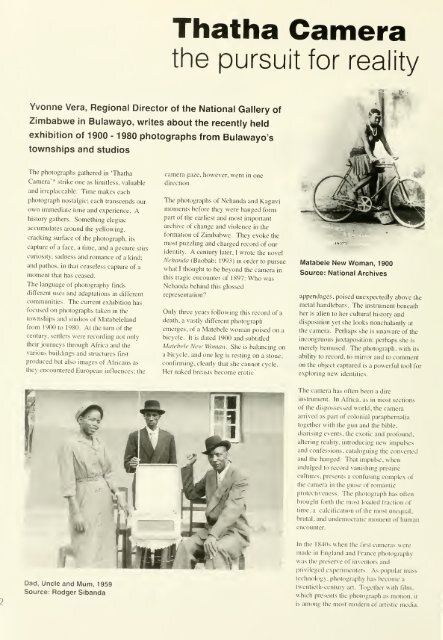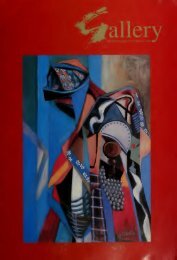Untitled - gallery delta
Untitled - gallery delta
Untitled - gallery delta
You also want an ePaper? Increase the reach of your titles
YUMPU automatically turns print PDFs into web optimized ePapers that Google loves.
Yvonne Vera, Regional Director of the National Gallery of<br />
Zimbabwe in Bulawayo, writes about the recently held<br />
exhibition of 1900 - 1980 photographs from Bulawayo's<br />
townships and studios<br />
The photographs gathered in 'Thatha<br />
Camera* strike one as Hmitless, valuable<br />
and irreplaceable. Time makes each<br />
photograph nostalgic; each transcends our<br />
own immediate time and experience. A<br />
history gathers. Something elegiac<br />
accumulates around the yellowing,<br />
cracking surface of the photograph, its<br />
capture of a face, a time, and a gesture stirs<br />
curiosity, sadness and romance of a kind;<br />
and pathos, in that ceaseless capture of a<br />
moment that has ceased.<br />
The language of photography finds<br />
different uses and adaptations in different<br />
communities. The current exhibition has<br />
focused on photographs taken in the<br />
townships and studios of Matabeleland<br />
from 1900 to 1980, At the turn of the<br />
century, settlers were recording not only<br />
their journeys through Africa and the<br />
various buildings and structures first<br />
produced but also images of Africans as<br />
they encountered European influences; the<br />
Dad, Uncle and Mum, 1959<br />
Source: Rodger SIbanda<br />
Thatha Camera<br />
the pursuit for reality<br />
camera gaze, however, went in one<br />
direction.<br />
The photographs of Nehanda and Kaguvi<br />
moments before they were hanged form<br />
part of the earliest and most important<br />
archive of change and violence in the<br />
formation of Zimbabwe. They evoke the<br />
most puzzling and charged record of our<br />
identity. A century later, I wrote the novel<br />
Nehanda (Baobab; 1993) in order to pursue<br />
what I thought to be beyond the camera in<br />
this tragic encounter of 1897: Who was<br />
Nehanda behind this glossed<br />
representation?<br />
Only three years following this record of a<br />
death, a vastly different photograph<br />
emerges, of a Matebele woman poised on a<br />
bicycle. It is dated 1900 and subtitled<br />
Matebele New Woman. She is balancing on<br />
a bicycle, and one leg is resting on a stone.<br />
confirming, cleariy that she cannot cycle.<br />
Her naked breasts become erotic<br />
Matabele New Woman, 1900<br />
Source: National Archives<br />
appendages, poised unexpectedly above the<br />
metal handlebars. The instrument beneath<br />
her is alien to her cultural history and<br />
disposition yet she looks nonchalantly at<br />
the camera. Perhaps she is unaware of the<br />
incongruous juxtaposition; perhaps she is<br />
merely bemu.sed. The photograph, with its<br />
ability to record, to mirror and to comment<br />
on the object captured is a powerful tool for<br />
exploring new identities.<br />
The camera has often been a dire<br />
instrument. In Africa, as in most sections<br />
of the dispossessed world, the camera<br />
arrived as part of colonial paraphernalia<br />
together with the gun and the bible,<br />
diarising events, the exotic and profound,<br />
altering reality, introducing new impulses<br />
and confessions, cataloguing the converted<br />
and the hanged. That uiipulse. when<br />
mdulged to record vanishing pristine<br />
cultures, presents a confusing complex of<br />
the camera in the guise of romantic<br />
protectiveness. The photograph has often<br />
brought forth the most loaded fraction of<br />
lime, a calcification of the most unequal,<br />
brutal, and undemocratic moment of human<br />
encounter.<br />
In the I S4()s when the tirst cameras were<br />
made in England and France photography<br />
was the preserve of inventors and<br />
privileged experimenters. As popular mass<br />
Icchnolog) . photography has become a<br />
twentieth-century art. Together with film,<br />
which presents the photograph as motion, it<br />
is among the most inodern of artistic media.







